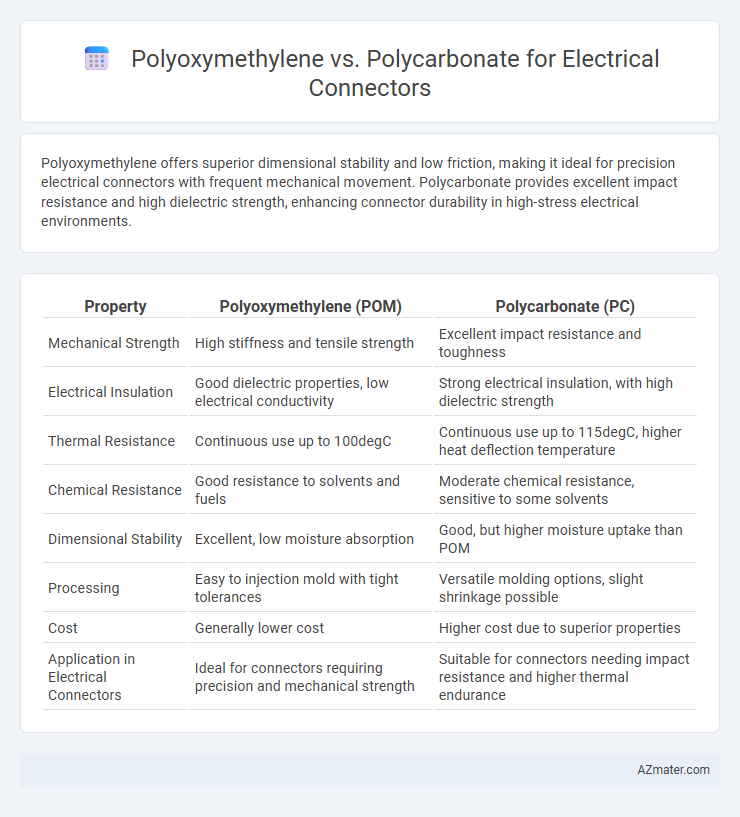Polyoxymethylene offers superior dimensional stability and low friction, making it ideal for precision electrical connectors with frequent mechanical movement. Polycarbonate provides excellent impact resistance and high dielectric strength, enhancing connector durability in high-stress electrical environments.
Table of Comparison
| Property | Polyoxymethylene (POM) | Polycarbonate (PC) |
|---|---|---|
| Mechanical Strength | High stiffness and tensile strength | Excellent impact resistance and toughness |
| Electrical Insulation | Good dielectric properties, low electrical conductivity | Strong electrical insulation, with high dielectric strength |
| Thermal Resistance | Continuous use up to 100degC | Continuous use up to 115degC, higher heat deflection temperature |
| Chemical Resistance | Good resistance to solvents and fuels | Moderate chemical resistance, sensitive to some solvents |
| Dimensional Stability | Excellent, low moisture absorption | Good, but higher moisture uptake than POM |
| Processing | Easy to injection mold with tight tolerances | Versatile molding options, slight shrinkage possible |
| Cost | Generally lower cost | Higher cost due to superior properties |
| Application in Electrical Connectors | Ideal for connectors requiring precision and mechanical strength | Suitable for connectors needing impact resistance and higher thermal endurance |
Introduction to Polyoxymethylene and Polycarbonate
Polyoxymethylene (POM) is a high-performance engineering thermoplastic known for its excellent dimensional stability, low friction, and superior mechanical strength, making it ideal for electrical connectors requiring precision and durability. Polycarbonate (PC) offers high impact resistance, thermal stability, and good electrical insulation properties, which are critical for connectors exposed to mechanical stress and elevated temperatures. Both materials are widely used in the electrical industry, with POM favored for mechanical precision and low wear, while PC excels in impact resistance and thermal endurance.
Material Properties Overview
Polyoxymethylene (POM) offers excellent dimensional stability, high mechanical strength, and low moisture absorption, making it ideal for precise electrical connector components that require durability and consistent performance. Polycarbonate (PC) provides superior impact resistance, flame retardancy, and thermal stability, which enhances electrical connectors' safety and longevity in demanding environments. Both materials exhibit electrical insulation properties; however, POM generally excels in wear resistance while PC outperforms in heat resistance and transparency.
Mechanical Strength Comparison
Polycarbonate exhibits higher impact resistance and tensile strength compared to polyoxymethylene, making it more suitable for electrical connectors requiring superior mechanical durability. Polyoxymethylene offers excellent stiffness and dimensional stability but has lower toughness, which can lead to brittleness under mechanical stress. For applications demanding robust mechanical strength and resistance to repeated impacts, polycarbonate is generally the preferred material.
Electrical Insulation Capabilities
Polyoxymethylene (POM) offers excellent electrical insulation properties with a high dielectric strength around 20-25 kV/mm, making it suitable for low to medium voltage electrical connectors. Polycarbonate (PC) provides good electrical insulation as well, with a dielectric strength typically ranging from 15-20 kV/mm, but excels in impact resistance and dimensional stability under heat exposure. For applications prioritizing superior electrical insulation performance and stable dielectric constant, POM is often favored over PC in electrical connector manufacturing.
Thermal Resistance and Stability
Polyoxymethylene (POM) exhibits excellent dimensional stability and low thermal expansion, making it suitable for electrical connectors operating under moderate temperatures up to 100degC. Polycarbonate (PC) offers superior thermal resistance with a higher glass transition temperature around 147degC, enabling better performance in environments with elevated thermal stress. The enhanced thermal stability of polycarbonate ensures reliable electrical insulation and mechanical integrity in high-temperature applications, whereas polyoxymethylene is favored for its rigidity and low moisture absorption in less demanding thermal conditions.
Chemical Resistance Performance
Polyoxymethylene (POM) exhibits excellent chemical resistance to solvents, fuels, and alkalis, making it highly suitable for electrical connectors exposed to harsh chemicals. Polycarbonate (PC) offers moderate chemical resistance but can degrade when exposed to strong acids or organic solvents, limiting its use in chemically aggressive environments. For electrical connectors requiring superior performance against chemical exposure, POM is generally preferred due to its stable molecular structure and resistance to a wide range of chemicals.
Dimensional Stability and Precision
Polyoxymethylene (POM) offers exceptional dimensional stability and high precision due to its low moisture absorption and minimal thermal expansion, making it ideal for electrical connectors requiring tight tolerances. Polycarbonate (PC) provides good dimensional stability but exhibits higher moisture uptake and thermal expansion compared to POM, potentially affecting long-term precision in humid or varying temperature environments. For applications demanding maximal dimensional accuracy and consistent fit, POM outperforms PC in maintaining connector integrity over time.
Processing and Manufacturing Differences
Polyoxymethylene (POM) offers superior machinability with low friction and dimensional stability, making it ideal for precision electrical connector components. Polycarbonate (PC) excels in injection molding with high impact resistance and thermal stability, but may require controlled cooling to avoid warping in complex connector geometries. Processing POM typically involves extrusion or molding at lower temperatures compared to PC, which demands higher molding temperatures and can undergo post-processing treatments to enhance electrical insulation properties.
Cost Analysis for Electrical Connectors
Polyoxymethylene (POM) offers a lower material cost compared to polycarbonate (PC) for electrical connectors, making it a budget-friendly choice for high-volume production. POM exhibits excellent dimensional stability and wear resistance, reducing long-term maintenance expenses, whereas PC provides superior impact strength and heat resistance but at a higher price point. Cost analysis reveals POM components often result in lower overall expenses due to reduced raw material costs and efficient manufacturability in connector applications.
Application Suitability and Recommendations
Polyoxymethylene (POM) offers excellent dimensional stability and wear resistance, making it suitable for electrical connectors requiring precision and mechanical strength in low to moderate temperature environments. Polycarbonate (PC) provides superior impact resistance and higher thermal stability, ideal for connectors exposed to elevated temperatures or potential mechanical shocks. For applications demanding prolonged heat exposure and robust durability, polycarbonate is recommended, whereas polyoxymethylene is preferable for cost-effective, wear-resistant connectors in standard electrical assemblies.

Infographic: Polyoxymethylene vs Polycarbonate for Electrical Connector
 azmater.com
azmater.com